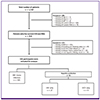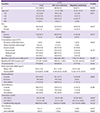1. Buchacz K, Baker RK, Palella FJ Jr, Chmiel JS, Lichtenstein KA, Novak RM, Wood KC, Brooks JT. HOPS Investigators. AIDS-defining opportunistic illnesses in US patients, 1994-2007: a cohort study. AIDS. 2010; 24:1549–1559.

2. Schwarcz L, Chen MJ, Vittinghoff E, Hsu L, Schwarcz S. Declining incidence of AIDS-defining opportunistic illnesses: results from 16 years of population-based AIDS surveillance. AIDS. 2013; 27:597–605.
3. Kim MJ, Chang HH, Kim SI, Kim YJ, Park DW, Kang C, Kee MK, Choi JY, Kim SM, Choi BY, Kim WJ, Kim JM, Choi JY, Choi YH, Lee JS, Kim SW, Korea H. Korea HIV/AIDS Cohort Study. Trend of CD4+ Cell Counts at Diagnosis and Initiation of Highly Active Antiretroviral Therapy (HAART): Korea HIV/AIDS Cohort Study, 1992-2015. Infect Chemother. 2017; 49:101–108.

4. Alter MJ. Epidemiology of viral hepatitis and HIV co-infection. J Hepatol. 2006; 44:Suppl. S6–S9.

5. Bica I, McGovern B, Dhar R, Stone D, McGowan K, Scheib R, Snydman DR. Increasing mortality due to end-stage liver disease in patients with human immunodeficiency virus infection. Clin Infect Dis. 2001; 32:492–497.

6. Hoffmann CJ, Thio CL. Clinical implications of HIV and hepatitis B co-infection in Asia and Africa. Lancet Infect Dis. 2007; 7:402–409.

7. Nikolopoulos GK, Paraskevis D, Hatzitheodorou E, Moschidis Z, Sypsa V, Zavitsanos X, Kalapothaki V, Hatzakis A. Impact of hepatitis B virus infection on the progression of AIDS and mortality in HIV-infected individuals: a cohort study and meta-analysis. Clin Infect Dis. 2009; 48:1763–1771.

8. Sánchez-Quijano A, Andreu J, Gavilán F, Luque F, Abad MA, Soto B, Muñoz J, Aznar JM, Leal M, Lissen E. Influence of human immunodeficiency virus type 1 infection on the natural course of chronic parenterally acquired hepatitis C. Eur J Clin Microbiol Infect Dis. 1995; 14:949–953.

9. Soto B, Sánchez-Quijano A, Rodrigo L, del Olmo JA, García-Bengoechea M, Hernández-Quero J, Rey C, Abad MA, Rodríguez M, Sales Gilabert M, González F, Mirón P, Caruz A, Relimpio F, Torronteras R, Leal M, Lissen E. Human immunodeficiency virus infection modifies the natural history of chronic parenterally-acquired hepatitis C with an unusually rapid progression to cirrhosis. J Hepatol. 1997; 26:1–5.

10. Rockstroh JK. Influence of viral hepatitis on HIV infection. J Hepatol. 2006; 44:Suppl. S25–S27.

11. Lee SH, Kim KH, Lee SG, Chen DH, Jung DS, Moon CS, Park JY, Chung JS, Kwak IS, Cho GJ. Trends of mortality and cause of death among HIV-infected patients in Korea, 1990-2011. J Korean Med Sci. 2013; 28:67–73.

12. Lee S, Lee SH, Lee SJ, Kim KH, Lee JE, Cho H, Lee SG, Chung JS, Kwak IS. Incidence and risk factors of hepatitis C virus infection among human immunodeficiency virus (HIV) patients in a large HIV clinic in South Korea. Korean J Intern Med. 2016; 31:772–778.

13. Adekunle AE, Oladimeji AA, Temi AP, Adeseye AI, Akinyeye OA, Taiwo RH. Baseline CD4+ T lymphocyte cell counts, hepatitis B and C viruses seropositivity in adults with Human Immunodeficiency Virus infection at a tertiary hospital in Nigeria. Pan Afr Med J. 2011; 9:6.
14. Koziel MJ, Peters MG. Viral hepatitis in HIV infection. N Engl J Med. 2007; 356:1445–1454.

15. Kellerman SE, Hanson DL, McNaghten AD, Fleming PL. Prevalence of chronic hepatitis B and incidence of acute hepatitis B infection in human immunodeficiency virus-infected subjects. J Infect Dis. 2003; 188:571–577.

16. Sungkanuparph S, Vibhagool A, Manosuthi W, Kiertiburanakul S, Atamasirikul K, Aumkhyan A, Thakkinstian A. Prevalence of hepatitis B virus and hepatitis C virus co-infection with human immunodeficiency virus in Thai patients: a tertiary-care-based study. J Med Assoc Thai. 2004; 87:1349–1354.
17. Korea Centers for Disease Control and Prevention (KCDC). Korea health statistics 2013: Korea National Health and Nutrition Examination Survey (KNHANES VI-1). Accessed 30 January, 2017. Available at:
http://knhanes.cdc.go.kr/knhanes/index.do.
18. Kim DY, Kim IH, Jeong SH, Cho YK, Lee JH, Jin YJ, Lee D, Suh DJ, Han KH, Park NH, Kang HY, Jung YK, Kim YS, Kim KA, Lee YJ, Lee BS, Yim HJ, Lee HJ, Baik SK, Tak WY, Lee SJ, Chung WJ, Choi SK, Cho EY, Heo J, Kim DJ, Song BC, Kim MW, Lee J, Chae HB, Choi DH, Choi HY, Ki M. A nationwide seroepidemiology of hepatitis C virus infection in South Korea. Liver Int. 2013; 33:586–594.

19. Kourtis AP, Bulterys M, Hu DJ, Jamieson DJ. HIV-HBV coinfection--a global challenge. N Engl J Med. 2012; 366:1749–1752.
20. Amin J, Kaye M, Skidmore S, Pillay D, Cooper DA, Dore GJ. HIV and hepatitis C coinfection within the CAESAR study. HIV Med. 2004; 5:174–179.

21. Barth RE, Huijgen Q, Taljaard J, Hoepelman AI. Hepatitis B/C and HIV in sub-Saharan Africa: an association between highly prevalent infectious diseases. A systematic review and meta-analysis. Int J Infect Dis. 2010; 14:e1024–e1031.

22. Moreira M, Ramos A, Netto EM, Brites C. Characteristics of co-infections by HCV and HBV among Brazilian patients infected by HIV-1 and/or HTLV-1. Braz J Infect Dis. 2013; 17:661–666.

23. Chen X, He JM, Ding LS, Zhang GQ, Zou XB, Zheng J. Prevalence of hepatitis B virus and hepatitis C virus in patients with human immunodeficiency virus infection in Central China. Arch Virol. 2013; 158:1889–1894.

24. Platt L, Easterbrook P, Gower E, McDonald B, Sabin K, McGowan C, Yanny I, Razavi H, Vickerman P. Prevalence and burden of HCV co-infection in people living with HIV: a global systematic review and meta-analysis. Lancet Infect Dis. 2016; 16:797–808.

25. Rao VB, Johari N, du Cros P, Messina J, Ford N, Cooke GS. Hepatitis C seroprevalence and HIV co-infection in sub-Saharan Africa: a systematic review and meta-analysis. Lancet Infect Dis. 2015; 15:819–824.








 PDF
PDF ePub
ePub Citation
Citation Print
Print



 XML Download
XML Download